Side Menu:
Fifth Officer Harold Lowe
- Post-Titanic and War

A photograph of Harold Lowe post-Titanic disaster.
Likely in New York if you compare it with the photograph
from the Evening Star on April 25, 1912. At the reception
in Barmouth he was only able to utter "a single sentence"
according to one newspaper report.
Finally, after the harrowing experience of a shipwreck and two demanding inquiries, on the 21st of June 1912 Lowe returned to his home town of Barmouth to be met with 1,300 people who attended a reception held in his honor at the Picture Pavilion.
During April and May of 1912, when reports of his efforts during the sinking were being published by the media, a pamphlet was distributed around his home town of Barmouth in an effort to raise funds for a gift. Consequently, he was presented with a commemorative gold watch, with the inscription "Presented to Harold Godfrey Lowe, 5th officer R.M.S. Titanic by his friends in Barmouth and elsewhere in recognition and appreciation of his gallant services at the foundering of the Titanic 15th April 1912."
The Sunday Times (Sydney) of the 11th of August 1912, under the erroneous heading of "Titanic's First Officer" ran an article detailing the event, and the interesting comment that Lowe was so overcome with emotion that he could only express himself with "a single sentence":
TITANIC'S FIRST[sic] OFFICER
A crowded public meeting was held at Barmouth, England, recently, to do honour to Harold Lowe, first[sic] officer of the Titanic. The chairman the Rev. Gwynoro Davies, on behalf of Mr. Lowe's fellow-townsmen, presented him with a gold watch and chain, also an album containing the names of over 400 subscribers, and watercolour drawings of Barmouth views. On behalf of Mrs. Harris of New York, the chairman also presented Mr. Lowe with a complete set of nautical instruments in a case, costing 100 guineas, as a mark of esteem and gratitude for his gallant conduct "on that tragic Sunday night."
Mr Lowe it is chronicled, was so overcome by his feelings at this mark of esteem on the part of his Barmout friends that he was only able to express his feelings in a single sentence.
(Sunday Times (Sydney) 11 August 1912, courtesy of Inger Sheil)
The "complete set of nautical instruments in a case" sent by "Mrs. Harris of New York" remained in the Lowe family possession until November 2020 when it was auctioned at Henry Aldridge & Son Ltd, along with a telescope bearing the same inscription from Mrs Harris:
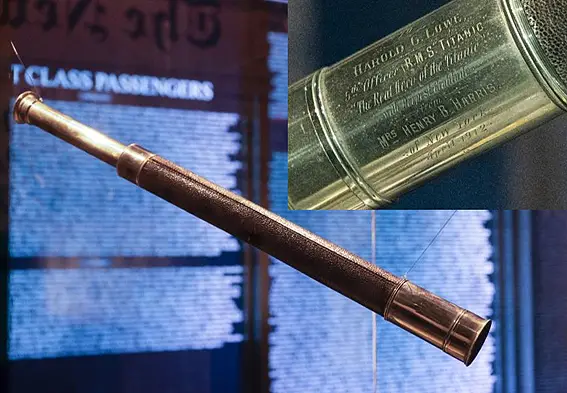
An early 20th century telescope given to Fifth Officer Lowe by Mrs Harris, engraved "To Harold G. Lowe Fifth Officer R.M.S. Titanic, The Real Hero of the Titanic".
Images: Henry Aldridge & Son Ltd
(Click image to enlarge)

An early 20th century sextant made by Heath & Co. London in its original carrying case with an inscribed brass plaque 'To Harold G Lowe Fifth Officer RMS Titanic "The real hero of the Titanic" with deepest gratitude from Mrs Irene Harris N.Y. April 1912'.
Images: Henry Aldridge & Son Ltd
(Click image to enlarge)
Lowe later joined the watch chain that was given to him as part of the Barmouth presentation set with a gold sovereign that was given to him from an unidentified survivor aboard the Carpathia. Researcher Inger Sheil notes that according to Lowe "the survivor approached him and asked for a souvenir (or 'keepsake', as Harold W G Lowe recalled the wording) in exchange for one of the gold sovereigns he had in his pocket. Lowe suggested a bullet 'which you nearly got' for attempting to jump in a lifeboat. The exact sequence is a bit unclear - unfortunately, as far as I know, HGL never committed the account to paper and so we are reliant on HWGL's recollection of what his father told him. In a version HWGL wrote down, he suggests it was one of the men who jumped into 14 from the decks of Titanic."
He was later photographed proudly displaying the watch chain and sovereign, revealing that he treasured these particular items.

The watch chain and sovereign. Courtesy of Inger Sheil/Lowe family collection. (Click image to enlarge)
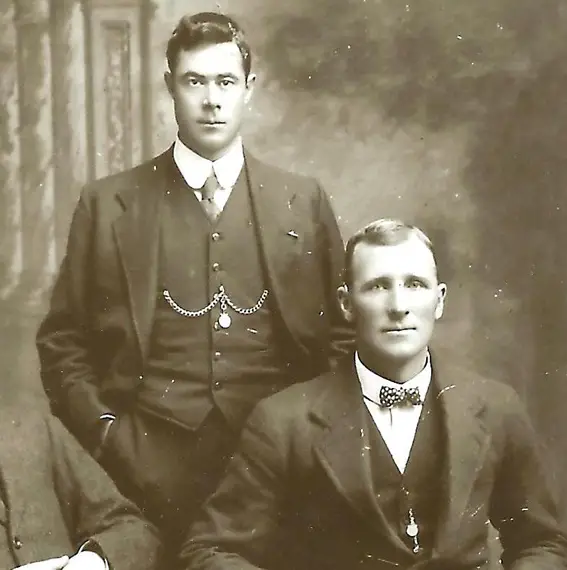
Harold Lowe with his friend and champion sculler Harry Pearce. He is apparently wearing the watch chain and sovereign he received in recognition for his efforts during the Titanic disaster. Courtesy of Inger Sheil/Lowe family collection. (Click image to enlarge)
RMS Medic - Australia
According to Lowe's White Star Line service records, he recommenced working for the company by joining the RMS Medic on the 6th of July 1912, as Fourth Officer, until the 31st of July 1912 at which point he was promoted to Third Officer aboard the Medic until the 13th of December 1912. The Medic was of course a well-known ship among Titanic's officers - Wilde, Murdoch and Lightoller had all served aboard her on her voyages to Australia.
His visit "down-under" also made the news in which he expressed that he was "so sick of it all" and "disinclined to discuss the tragedy". In the 21st of September 1912 edition of The Argus (Victoria), the following article was printed:
TITANIC DISASTER RECALLED.
OFFICER VISITS AUSTRALIA.
Interest in the Titanic disaster is to a slight extent revived here by a visit from Mr. H. G. Lowe, who was fifth officer of the lost liner, and who was in charge of one of the boats picked up by the Carpathia. Mr. Lowe is now third officer of the "White Star" liner Medic, which is at present in port here, but is to sail for Sydney this morning. For various reasons, one of which is that he is "so sick of it all," and desires, if possible, to forget the past. Mr. Lowe is disinclined to discuss the tragedy. He was not on duty when the collision occurred, and was one of those who were roused from sleep. It was he who was asked by Senator Smith, during the American inquiry into the disaster what icebergs were composed of, where they came from, why did not the captain of the Titanic anchor his ship, and several other questions, which aroused much surprise and comment. Mr. Lowe is about 25 years old.
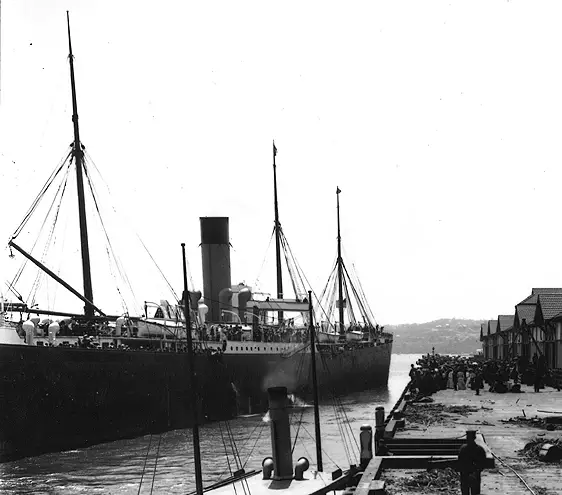
The SS Medic departing Dalgetty's wharf at Millers Point, Sydney, 8 May 1903. Lowe became something of a celebrity aboard the Medic when he visited Australia in 1912. Image credit: Australian National Maritime Museum.
(Click image to enlarge)
A few days later and Lowe's reluctance had become a point blank refusal to talk about Titanic, according this report:

Clipping from The Border Morning Mail and Riverina Times dated 24 September 1912, describing the Medic's arrival in Sydney and Lowe refusing to talk about Titanic. (Courtesy Inger Sheil)
For a brief time he was listed aboard the Afric (13.12.12 - 19.12.12) but his next ship was the SS Gothic from the 19th of December 1912 until the 20th of April 1913, in the capacity of Third Officer, on the service to Australia.

White Star Liner SS Gothic in Port Chalmers, Dunedin, New Zealand 1893-1899. Image credit: Alexander Turnbull Library, Wellington, New Zealand .
(Click image to enlarge)
His White Star Line record lists him as "Drill" from the 3rd of May to 31st of May 1913 before a change of scenery had him on the voyages to Montreal - a total of six voyages aboard the Cornishman, promoted to Second Officer, from the 2nd of July 1913 until the 11th of March 1914.

An excerpt from Lowe's White Star Line Service Record from Titanic through to the end of the war.
There was a third Titanic inquiry that Lowe had to appear at, on Monday the 23rd of June 1913, in the Royal Courts of Justice in the Strand, London, during which he restated most of what he had already confirmed during the previous investigations. The case was primarly about Thomas Ryan recovering damages over the loss of his son Patrick Ryan. ("The Third Titanic Inquiry - Ryan v. OSNC Transcript of Precis Law Report," Encyclopedia Titanica)

Wedding announcement: The North Wales Weekly News
(Colwyn Bay, Clwyd, Wales), 26 September 1913.
Marriage

Harold Lowe's wife, Ellen Whitehouse, also known as
"Nellie" c.1912 (Credit: Titanic Valour/Inger Sheil/
Lowe Family Collection/John Lowe).
During 1913 love was also in the air. For some time now Harold Lowe had been courting Ellen Whitehouse (born 16 April 1885), known as "Nellie" and the two married on the 24th of September 1913 in St Paul's Church in Colwyn Bay.
Indeed, the newlyweds settled in Colwyn Bay. His RNR records listed the address as: Bryn Mostyn, Colwyn Bay. According to Inger Sheil, this address was the home of Lowe's father-in-law, who was in poor health and required nursing care (Titanic Valour, Inger Sheil)
RNR Drill
Lowe's White Star Records then list him as on "drill" from the dates 11.3.14 - 10.4.14. Cross-checking this with his Navy records we see that he underwent training in May 1913 through to June 1913.
Lowe had been appointed an "acting" (probationary) sub-Lieutenant in the Royal Navy Reserve shortly after this experience aboard Titanic - on the 6th of July 1912 according to the records.
His training began on the 3rd of May 1913 aboard the HMS Implacable in Sheerness. With the emergence of the dreadnought class ships, this Formidable-lcass battleship had been reassigned to the home fleet in 1912. Lowe trained aboard her for two periods of time ending on the 2nd of June 1913. His records mark him as "VG" (very good) and he was officially appointed to the rank of Sub Lieutenant on the 14th of June 1913.

HMS Implacable at Malta in 1908 (Maritime Quest).
There is a noticeable gap in the records between June 1913 and April 1914 but by the 4th of April 1914 he was back to training, including Gunner and Torpedo training on the HMS Excellent and HMS Vernon, just as Titanic's original second officer, David Blair, had trained between 1908 and 1910.
The HMS Excellent was a Royal Navy "stone frigate" (shore establishment) sited on Whale Island near Portsmouth in Hampshire, (also known as Portsmouth Gunnery School). Lowe, as David Blair had done, was then moved to another shore establishment - the HMS Vernon, the Royal Navy's Torpedo Branch also known as the Torpedo School.

H.M.S. Excellent (Gunnery Training School) in 1869
(http://www.dreadnoughtproject.org/)
Lowe returned to the HMS Excellent for a longer period of time (5.4.14 - 5.6.14) and then briefly the HMS Hogue (15.7.14 - 25.7.14).
HMS Victory
Lowe was officially assigned to the HMS Victory on the dates listed 6.6.14 - 1.1.16. The HMS Victory was of course, Lord Nelson's flagship at the Battle of Trafalgar in 1805, that is still in commission today (although dry docked). When Lowe was assigned it was likely used as headquarters and training in Portsmouth. Effectively it meant that Lowe was staying on land for the time being. War was brewing in Europe so that was likely to change.
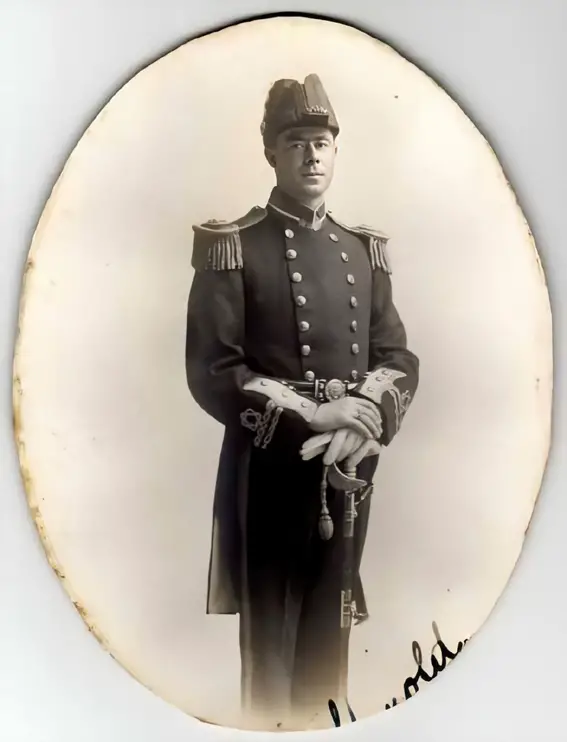
Harold Lowe in his full RNR uniform, including his bicorn hat and sword. Image: Inger Sheil/Titanic Valour (Click image to enlarge)
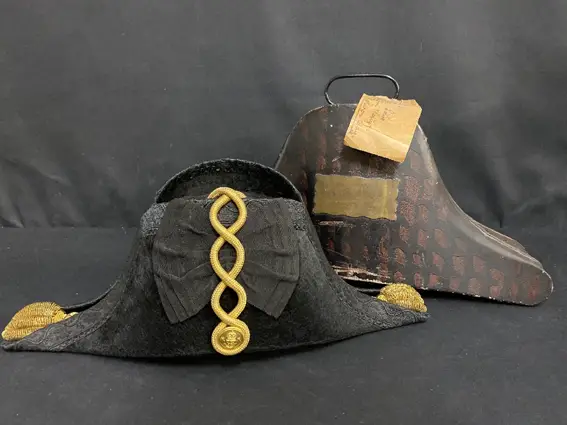
Lowe’s Royal Naval Reserve Ceremonial Bicorn hat that went up for auction in 2020. Image: Henry Aldridge & Son (Click image to enlarge)
First Child
World War One broke out at the beginning of August 1914 but back home Lowe had something else on his mind. Nellie was pregnant and on the 20th of November 1914 gave birth to their first child, daughter Florence Josephine Edge Lowe, better known as “Josie”.
World War One
In April 1914, Harold Lowe had commenced training to become a full lieutenant in the RNR. World war was now imminent. On 29th July, 1914 the British Admiralty sent a ‘warning telegram’ to the fleets, and on 1st of August the order was given for full naval mobilization. The following day, 2nd of August 1914, Lowe wrote out his will with just a single line: “I leave everything to my wife & anything I might inherit.”)
According to Lowe's White Star Line records, he was away as part of the Royal Navy from the 10th of April 1914 until the 15th of October 1919, which roughly equates with his Navy records which place Lowe training and then aboard three ships between the 6th of June 1914 and the 30th of June 1917. The following is based on those records.
In the meantime, on the 20th of July 1915, Lowe had been promoted to Lieutenant.

Lowe's Navy record for this period is hardly legible.
(Click image to enlarge)
HMS Donegal
For almost all of the war, Lowe was assigned to the HMS Donegal, with his Navy records stating his time aboard as from the 2nd of January 1916 until the 20th of April 1917.
The Donegal was an Monmouth-class armoured cruiser launched in 1902. Having been refitted at the beginning of the war the Donegal was assigned to the the 6th Cruiser Squadron of the Grand Fleet in January 1915 and then to the 7th Cruiser Squadron in November to escort convoys to Archangelsk. In March she was reassigned to the 2nd Cruiser Squadron until she was transferred to the 9th Cruiser Squadron in the mid-Atlantic for convoy escort. Donegal rejoined the 4th Cruiser Squadron on North America and West Indies Station in 1917 and continued with convoy duties until the end of the war.
The log note when he joined the ship on the 3rd of January 1916 at Scapa Flow, which is at the very north of Scotland:
3 January 1916
At Scapa Flow
Lat 58.86, Long -3.10
[In F3 Berth Scapa Flow]
8.0am: Discharged 3 ratings to depôt.
am: Divisions, Prayers, Physical Exercise. Exercised “Prepare to tow aft”, “Close B and C Doors, prepare to Abandon ship”, “Work Main Derrick by Hand”.
11.30am: Lieutenant Lowe RNR joined ship. Received 1 rating from depôt.
pm: Training classes at instructions.
4.30pm: Weighed starboard anchor. Shortened to 6 shackles on port.
[Number on sick list: 6]
[Provisions received: Fresh Meat 725 lbs, Vegetables 1000 lbs]
(Credit: naval-history.net/Kay Smith)

An excerpt from the HMS Donegal's log dated 3 January 1916 reads: "11.30am: Lieutenant Lowe RNR joined ship." (Click image to enlarge)
According to the The Dreadnought Project, a naval history 'wiki' focusing on naval history in the period 1880-1920, when Lowe was aboard he would have served under Captain Warren H. D'Oyly, who was in command of the Donegal from 7 August, 1915 – late 1917. D'Oyly was sick for 10 weeks from mid-March 1916 and then developed eye trouble from late September, 1917, so there was a temporary master - Captain Charles A. Fountaine, 21 March, 1916 – 28 May, 1916. (http://www.dreadnoughtproject.org/)
The next mention of Lowe is his discharge, in Bermuda, in which he seems to have taken the SS “Chaudier” home:
30 March 1917
At Bermuda
Lat 32.32, Long -64.84
[Floating Dock]
9.30am: Landed Seamen and Marines for Company drill.
am: Lieutenant Lowe RNR discharged to depôt for SS “Chaudier” [Chaudiere, listed here]. Discharged 1 rating to hospital.
pm: Hands variously employed working in dockyard and painting and scraping ship.
[Number on sick list: 5]
[Provisions received: Fresh Meat 400 lbs, Vegetables 2000 lbs]
(Credit: naval-history.net/Kay Smith)

An excerpt from the HMS Donegal's log dated 30 March 1917 reads: "AM: Lieutenant Lowe RNR discharged to depôt for SS Chaudier" Image: naval-history.net/Kay Smith (Click image to enlarge)
Family
Lowe's return to England also meant he could meet a new member of the family, as on the 21st of March 1916, his son Harold William George Lowe was born. In a charming photograph, Lowe is pictured with his two young children in 1917, holding the young Harold, while daughter Florence Josephine (also known as "Josie") is seated on a chair next to him.
Lowe is pictured looking very happy with his two children, the one year old Harold William George Lowe and three year old Florence Josephine Lowe
(Tumblr/Titanic Valour/Inger Sheil)
HMS Excellent
Lowe was back home aboard the HMS Excellent for further training according to his Navy records, from the 1st of April 1917 until the 6th of May 1917. The training resulted in him being promoted to Lieutenant-Commander - he was notified on the 16th May 1917. The next day he signed on to the HMS Suffolk.
HMS Suffolk

HMS Suffolk (Click image to enlarge)
Lowe is listed as aboard the HMS Suffolk for a period of nearly two years - 17.5.1917 - 10.6.1919. Like the HMS Donegal, the Suffolk was also a Monmouth-class armoured cruiser launched in 1903.
According to Naval-history.net, the HMS Suffolk was in "transit from Plymouth to the Far East and operations based on Singapore and Hong Kong…June 1917 to January 1918:" Naval-history.net lists the logs dated 1 June 1917 through to the end of June, showing that the ship departed Plymouth and arrived in Sierra Leone on the 13th of June 1917, where it remained for a week and then departed on the 20th of June 1917 and arrived in Simon's Town, the Naval Base on the Wstern Cape of South Africa on the 4th of July. (https://www.naval-history.net/OWShips-WW1-05-HMS_Suffolk.htm) Lowe's own "personal photographic log from onboard H.M.S. Suffolk reveals a fascinating insight into the details of her journey and "contains numerous photos with written notations of Shanghai, Hong Kong, Aden, Suez...Vladivostok and Japan. The album contains a large number of high quality images of Suffolk, the crew, and Lowe himself in 1918, together with numerous press cuttings." (Henry Aldridge, November 2020 Titanic auction).
The other logs for this voyage list Durban, Mauritius, Port Louis, Singapore - arriving in Singapore on the 10th of August 1917 and then departing from there on the 28th of August 1917 then on to Penang in Malaysia, and Colombo, Hong Kong, Sasebo (Japan) and finally Vladivostok where it remained until January 1919. The HMS Suffolk was deployed to Vladivostok to support the Siberian Intervention against the Bolsheviks The same source lists Lieutenant E.W. Kitson as the Navigating Officer and Captain C.R Payne as master of the Suffolk during Lowe's time aboard.
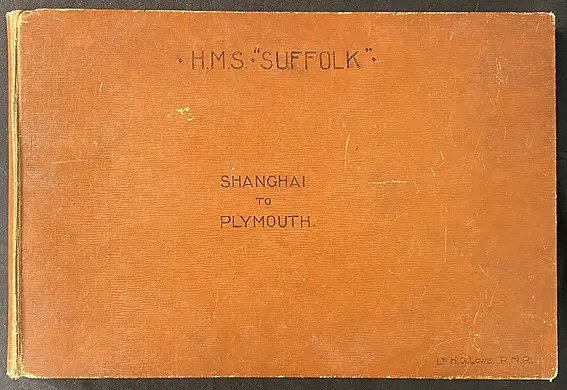
Lowe's personal photographic log from onboard H.M.S. Suffolk
Henry Aldridge & Son Ltd

Lowe's personal photographic log from onboard H.M.S. Suffolk, from Shanghai to Plymouth. The album contains numerous photos with written notations of Shanghai, Hong Kong, Aden, Suez. Image credit: Henry Aldridge & Son Ltd auction, "Titanic, Liner and Transport Memorabilia," Saturday 14th November 2020
(Click image to enlarge)
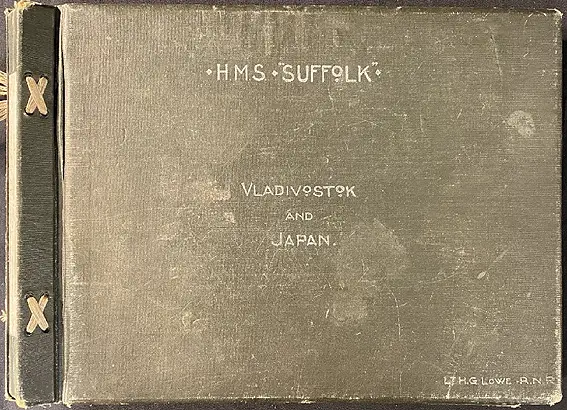
Lowe's personal photographic log from onboard H.M.S. Suffolk in Vladivostok and Japan. (Henry Aldridge & Son Ltd)

Harold Lowe in his "winter rig" and dog named "Puppsie." This photograph is included in Lowe's personal photographic log from onboard H.M.S. Suffolk in Vladivostok and Japan. The album contains a large number of high quality images of Suffolk, the crew, and Lowe himself in 1918, together with numerous press cuttings. Image credit: Henry Aldridge & Son Ltd auction, "Titanic, Liner and Transport Memorabilia," Saturday 14th November 2020 (Click image to enlarge)
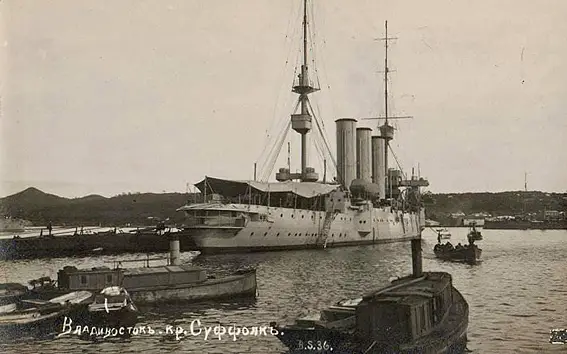
HMS Suffolk in a Vladivostok harbour in summer 1918 (Russian Titanic Society Collection)
Finally, with war having officially ended on the 11th of November 1918, Lowe's Navy records list him as "Demobilised" on the 10th of June 1919. Indeed Lowe was back with his family in June 1919, having served his time for 'King and Country'.
See also...
Next... Post-War